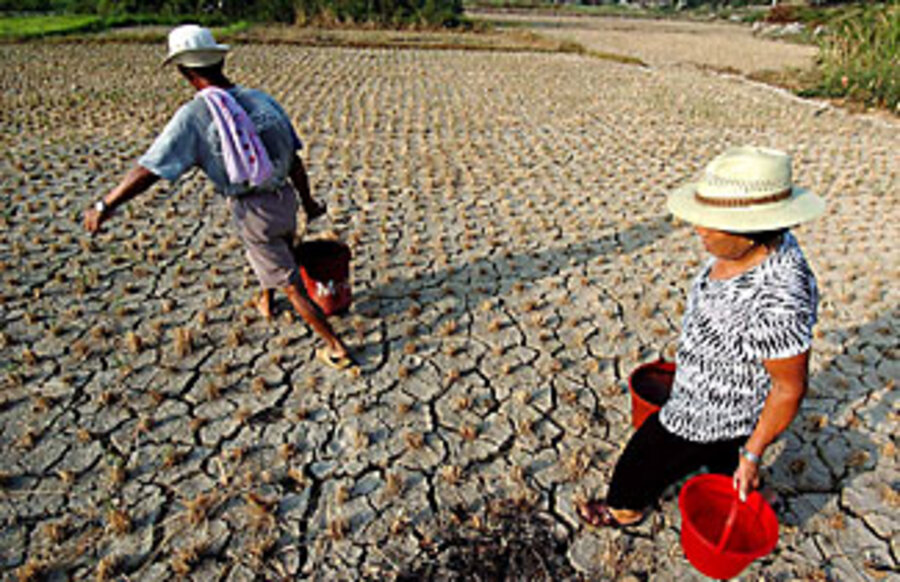Climate change: Southeast Asia's preparation falls short
Loading...
| Bangkok, Thailand
Facing rising sea levels, extreme weather patterns, and lower crop yields, countries in Southeast Asia are slowly waking up to the impact of climate change. Coastal towns in Vietnam are strengthening their sea walls. Communities in Thailand are replanting degraded mangroves. Forest practices are being overhauled in the Philippines.
But economists warn that these reactive efforts don't go far enough to tackle the threat to agrarian-based economies, which face potentially huge losses from failed crops and disaster relief. Far better to invest now, they argue, in adapting to more volatile weather before the full impact crashes through the region.
"Each government must realize that this investment is much cheaper now than later. They must realize this," says Tae Yong Jung, co-author of a new report by the Asian Development Bank (ADB) on the economic impact of climate change in the region.
Such investments would include climate-proofed infrastructure, energy-efficient industry, and forest-fire protection systems. Governments must also jointly safeguard common resources like rivers and cooperate on controlling disease outbreaks and managing disaster relief, the report advises.
Southeast Asia is seen as highly vulnerable to the impact of climate change because of its reliance on forestry and agriculture, which employs 43 percent of the workforce, and the concentration of large populations along exposed coastlines and rivers. Tens of millions of people live in fast-growing cities along the coast.
Under a scenario where global emissions continue to rise, the ADB predicts that sea levels could rise by 70 centimeters (27 inches) by the end of this century in a region where four in five people live within 65 miles of the coast.
Using models based on Britain's 2006 Stern Review, the ADB predicts that the cost of inaction on climate change could reach 6.7 percent of economic output by 2100 in Indonesia, Thailand, Vietnam, and the Philippines. This outstrips a global loss of 2.6 percent using the same scenario. It includes potential losses from weather events like typhoons and floods, as well as the cost of relocating millions of vulnerable people.
A warmer climate also poses unexpected challenges to health authorities, as the peak period for mosquito-borne diseases is extended. For vulnerable communities, shifts in such outbreaks go hand in hand with increased flooding, violent storms, and other climate-driven threats.
"It's very obvious when a cyclone hits you…. It's much harder for the collective consciousness to grapple with the idea that there is a changing pattern of disease in a city," says Ashvin Dayal, managing director in Asia for the New York-based Rockefeller Foundation, which is funding adaptation projects in six cities in Vietnam and India as part of a five-year, $70 million program.
Scientists generally agree that global temperatures will continue to rise, even if efforts to cap greenhouse-gas emissions bear fruit. But forecasting exact temperatures and how they affect various ecosystems is complex. Moreover, climatologists say that monsoon patterns are equally, if not more, crucial to farmers in regions like Southeast Asia.
The ADB predicts that Indonesia, Thailand, and Vietnam will face drier conditions over the next two to three decades, before the pattern reverses mid-century and brings more rainfall. By contrast, the Philippines should expect increasing precipitation. Using a 1990 baseline and a high-emissions scenario, annual temperatures in the four countries by 2100 could rise by 4.8 degrees C., as hot seasons become even hotter, putting greater stress on water resources.
Perhaps the biggest single negative impact could be on rice output. Thailand and Vietnam, which are among the world's largest rice exporters, face declining yields if rainfall patterns shift and low-lying fields are inundated by sea water. Another factor is crop pests that may emerge under new climatic conditions.
But while Southeast Asia is a victim of climate change, it also contributes to the problem by producing greenhouse gases that accounted for 12 percent of global emissions in 2000. That puts the onus on governments to invest in more efficient energy usage and switch to gas and renewable sources, says Zhuang Juzhong, assistant chief economist for the ADB.
By far the biggest polluter in the region is its forestry sector, however, in contrast to energy-derived emissions in rich countries like the United States. This stems from the logging of primary forests and of carbon-rich peat land, practices that have vaulted Indonesia into the top rung of carbon emitters. A boom in palm-oil exports has spurred countries to clear more tropical forests. Environmental campaigners have lobbied for a carbon-trading program that would reward countries for safeguarding their forests. A United Nations conference in December in Copenhagen is expected to incorporate this and other proposals into a new accord on curbing carbon emissions.
Some of these proposals may clash with the development goals of poor countries like Indonesia, particularly during a global downturn. But governments need to factor climate change into their stimulus plans while making sure that people living in vulnerable areas are part of the debate, says Emil Salim, a former environment minister in Indonesia.
"It's poverty alleviation first, coping with unemployment first," he told an ADB press conference, "before you talk about climate change."





